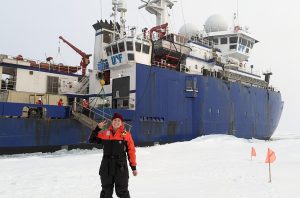Staff Spotlight: Brynn Kimber
CICOES Research Scientist
 Historically, whales, dolphins, and porpoises (i.e., cetaceans), have been somewhat mysterious in terms of their distribution, population structure, and hunting habits. But recent advancements in acoustic technology are being paired with traditional aerial surveys to shed more light on the movements and behavior of cetaceans. Brynn Kimber, a bioacoustics specialist and senior analyst with the Marine Mammal Laboratory’s acoustics team at NOAA’s Alaska Fisheries Science Center, is passionate about underwater sound. That passion fuels Brynn’s daily work, as they study thousands of hours of audio recordings with sounds from cetaceans, pinnipeds (seals), and human-generated noises recorded in the Bering, Chukchi, and Beaufort seas.
Historically, whales, dolphins, and porpoises (i.e., cetaceans), have been somewhat mysterious in terms of their distribution, population structure, and hunting habits. But recent advancements in acoustic technology are being paired with traditional aerial surveys to shed more light on the movements and behavior of cetaceans. Brynn Kimber, a bioacoustics specialist and senior analyst with the Marine Mammal Laboratory’s acoustics team at NOAA’s Alaska Fisheries Science Center, is passionate about underwater sound. That passion fuels Brynn’s daily work, as they study thousands of hours of audio recordings with sounds from cetaceans, pinnipeds (seals), and human-generated noises recorded in the Bering, Chukchi, and Beaufort seas.
Toothed whales (the Odontocete group, consisting of approximately 75 species including bowhead and orca whales) echolocate and make various sounds while hunting and navigating. They do this by sending out a series of clicks and then interpret the echoes these sounds make when they bounce back from objects. Baleen whales (the Mystecete group, containing approximately 14 species including gray whales and humpback whales) do not need to echolocate because they eat tiny crustaceans and fish using a filter-feeder system inside their mouths. They do, however, produce sounds that are used for communicating with one another. Imagine listening to this diverse set of sounds through an underwater recorder as these animals go about their daily routines! For Brynn, that’s another day at the office.
Brynn grew up in Bellingham, WA, and fell in love with the ocean while exploring the tidepools of Puget Sound and the San Juan Islands. Cephalopods, such as squid and octopus, were center stage as a child and drove Brynn to study marine biology at the University of Washington. It wasn’t until later, while attending a lecture on passive acoustic monitoring given by Kate Stafford, an associate professor at Oregon State University, that Brynn became interested in studying marine mammals and the way they interact with their environment. Brynn approached Kate after the lecture and volunteered to assist with her work. Little did Brynn know that this would be the doorway to a career as a research scientist with CICOES.

Now fully immersed in the field of acoustics, Brynn finds the most rewarding experiences come from going out into remote landscapes to witness firsthand how migration patterns and habits of marine mammals are impacted by climate change. At first, it was overwhelming to hear the diversity of their sounds and dialects, but over the years Brynn has become a high frequency specialist and expert at identifying pitches and noises.
The biggest surprise of Brynn’s career didn’t take place during a recent two-month research cruise in the Bering Sea — a remote location where researchers were dazzled by the aurora borealis and wowed by polar bears roaming the ice — but instead, it came while doing analysis back home in their Seattle offi ce. Brynn was looking at data from multiple cruises when they discovered a trend in orca distribution indicating that the whales were beginning to migrate further north than usual. These movements and changes in behavior are exactly what Brynn and colleagues are looking for through their analyses of acoustic data. Brynn’s work involves some fundamental challenges: overcoming seasickness, for starters, and then figuring out the intricacies of bioacoustic communications, and slowly surmounting the language barrier between humans and marine mammals. However, one of the greatest challenges Brynn encounters is manmade. The complexity of the data from the acoustic recorders is beyond the current analytical capabilities of computer technology, even using current Artifi cial Intelligence (AI) tools. The Marine Mammal Lab has been able to build an autodetector for multiple species that use simple calls, but species with complicated calls cannot be completely and accurately identifi ed by the AI. A bioacoustics specialist must still decipher these high-level sounds in a one-by-one, hands-on approach, until a more advanced technology has been developed. The desire to answer the bigger questions buried in acoustic data still remains very human and drives Brynn’s passion for the work.
